| | Grain temperature and moisture migration | Aerate for temperature control | Aeration air flow rates | Management of an aeration system | Fan operation | Peaking grain in storage | Managing fines in storage | Temperature sensing | Insect control instored grain | Safety practices
The main objective of proper grain storage is to maintain the quality and characteristics that the grain possessed immediately after harvesting and drying.
The quality of grain cannot be improved during storage. Grain improperly harvested and dried will remain of low quality no matter how well it is stored.
In cereal grains loss in quality and quantity during storage is caused by fungi, insects, rodents and mites. Respiration may, in certain cases, contribute to a loss of dry matter during grain storage. However, the losses due to respiration are minor compared to those caused by living organisms.
Fungi (molds) are the major cause of spoilage in grain. Losses caused by fungi in cereal grains are related to (1) a decrease in germination, (2) discoloration of the seed, (3) heating and mustiness, (4) biochemical changes, (5) possible production of toxins, and (6) loss in dry matter. All these changes may occur without the mold becoming visible to the naked eye.
There are two groups of mold that affect grain quality: field molds and storage molds.
Field molds invade kernels while the grain is still in the field. The field molds cause the discoloration of cereal grains often observed in plants exposed to very moist weather before harvest. In addition to affecting grain appearance, field mold may cause a decrease in the germination of the grain seeds.
Field mold damage is completed by the time the grain is harvested, and there is, therefore, relatively little that a producer can do about it. Once the grain is dried, these molds die or become inactive.
Storage molds are prevalent in storage facilities when the grain moisture content is too low for field molds (less than about 20%). The moisture and temperature requirements of these molds determine the safe storage period.
By controlling moisture content and temperature, mold growth is restricted and grain can be dried without significant spoilage. Grain temperature and moisture content determine the allowable storage time (AST) or how long grain can be kept before it spoils. Figure 1 gives an estimate of how much time you have to dry grain before it spoils, and how long you can maintain grain quality in storage.
Notice that as grain moisture content increases for a given temperature, the allowable storage time for drying and storing decreases. Also, as temperature increases, allowable storage time decreases. Mechanical damage to grain and the amount of foreign material also affects allowable storage time. Clean grain and whole seeds are more resistant to mold.
For long-term storage grain should be dried as soon as possible after it comes from the field. A delay in drying decreases the allowable storage time as shown in the following examples.
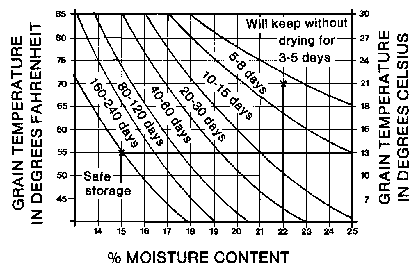
Figure 1.
Example 1. Grain is harvested at 22% moisture content and grain temperature is 21°C (70°F). How much time do you have before the grain spoils?
Answer. About 7 days (see Figure 1)
If the condition in the bin remains constant, the grain will drop one market grade in about 7 days, with the allowable storage time at 22% moisture content and 21°C (70°F).
Example 2. If at the end of 5 days, the grain in example 1 has been dried to 15% moisture and is at 13°C (55°F), how does the allowable storage time change?
Answer: During the first 5 days, 5/7 of the allowable storage time from example 1 was used up; 2/7 remain. The allowable storage time for the new condition, 15% moisture content and 13°C (55°F) temperature is 240 days (SE Figure 1).
But, only 2/7 of that time remains:
240 x 2/7 = 69 days
The total storage period for the grain in example 1, if left for 5 days before drying would only be 69 + 5 days = 74 days, compared to 240 days if it were dried immediately after harvest.
It should be stressed that the average moisture content throughout the grain bin does not determine how long cereal grains can be stored. Spoilage may occur at isolated locations in the bin where grain moisture is high. Grain stored in a bin at a relatively low average moisture conter of 13%, but with the moisture content ranging between 10% and 16%, is not safe for long-term storage because of the excessive moisture content (16%) of part of the grain.
Grain Temperature and Moisture Migration
More dried grain goes out of condition because grain temperatures are not controlled than for any other reason. Improper control of the temperature inside the bin causes moisture to move or migrate from one part of the grain mass to another, where the moisture can accumulate and cause grain spoilage problems.
Although moisture migration problems can occur any time grain temperatures vary considerably, the most critical time occurs when warm grain is stored in cold winter temperatures. This is especially true for large bins. In the fall, when the air temperature cools down, the grain along the bin wall cools more quickly than the rest of the grain. The difference in temperature starts air moving down the bin wall and toward the centre of the bin. As the air moves through the grain it becomes warmer and begins to pick up moisture from the grain. When the warm moist air hits the cool upper surface of the grain, condensation occurs (Figure 2). In the spring the problem is reversed. Warming action from the sun on the outside of the bin causes moisture currents to move up and into the bin. Condensation then occurs on the bottom of the bin (Figure 3).
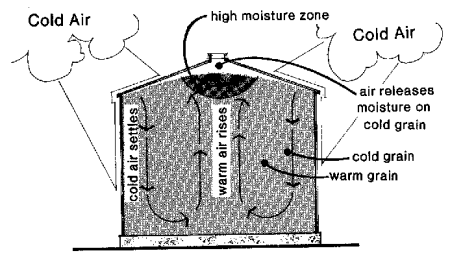
Figure 2.
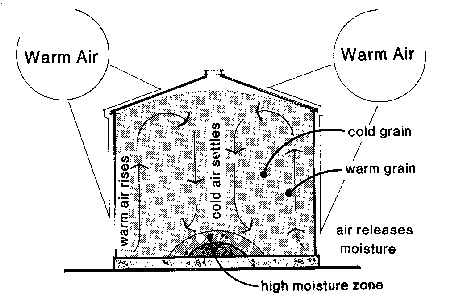
Figure 3.
Aerate for Temperature Control
Modern grain management uses aeration to control grain temperature and to reduce moisture variations. Aeration forces air through the grain either continuously or intermittently. Aeration is not a grain drying system and should not be used as one. Grain drying or rewetting is usually insignificant during grain aeration, because the cooling (or warming) front moves through the grain about 50 times faster than a drying or wetting front.
Grain can be tempered (cooled or warmed) by either negative or positive aeration systems. With either system, a tempering (cooling or warming) zone moves through the grain. The movement of the tempering zone completely through the grain is one cooling or warming cycle. Once a cycle had been started, operate the fan continuously until the zone moves completely through the grain. The time required to complete each cycle depends almost entirely on the aeration airflow rate.
In a positive pressure system (Figure 4), the tempering zone starts at the bottom of the bin and moves up. When moving air upwards, aeration progress can be easily determined by checking the grain temperature at the top centre. Also, with an upward airflow, the fan can be started immediately and air leaving the duct will keep the perforations clean.
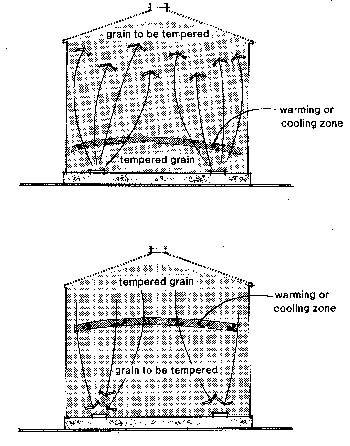
Figure 4.
In the negative pressure system, the tempering zone starts at the top of the bin and moves down. The main advantage is to minimize roof condensation when aerating warm grain in cold weather. The uncertainty of knowing when aeration is complete is the main disadvantage, since the grain at the bottom is the hardest to check.
Aeration Air Flow Rates
Airflow rates for aeration are normally 1 to 2 litres of air per second per cubic metre of grain (or 0.08 to 0.16 cubic feet of air per minute per bushel of grain).
The time for one cooling or warming cycle to completely pass through grain can be estimated by the following formula.
No. of hours to cool or warm the grain =
195/airflow rate (L/s-m3)
or
15/airflow rate (cfm/bu)
Where L/s-m3 = litres per second per cubic metre cfm/bu = cubic feet per minute per bushel. 1 cfm/bu = 13 L/s-m3
Management of an Aeration System
- Recommended air flow rates for aeration are 1-2 L/s-m3 (0.08 - 0.16 cfm/bu).
- The bin floor should be 15% perforated (minimum).
- Grain put into the bin should be within 1% of dry.
- Screen the grain to reduce foreign material and fines as they increase resistance to air flow and reduce total airflow.
- Level the top of the grain to promote uniform air flow through the grain mass.
- Operate the fan long enough to complete a cycle (cooling or warming).
Fan Operation
Fall
The grain should be cooled as quickly as possible. Start aerating as soon as the grain is in the bin. Check the grain temperature and turn off the fan when it is less than 5°C (9°F) above the outside temperature. Check the grain periodically for condensation or heating. If the grain will be kept over winter, turn the fan on again when the outside temperature gets colder and aerate until the grain temperature is less than 5°C (9°F) above the outside temperature. Continue these cooling stages until the entire volume of grain is close to O°C (32°F).
Winter
After turning the fan off, cover the opening with metal, canvas or plywood to keep the rodents out. When the outside temperature is close to that of the grain, run the fan for a day or two.
Spring
If the grain is being held over the summer, a series of warming stages beginning in April is recommended. Continue until the grain temperature is about 10°C (50°F).
Summer
By June the grain temperature should be 10°C (50°F). Check the grain periodically and run the fan during cool, fair weather when the outside temperature is lower than the grain temperature. If there are any signs of heating or hot spots, no matter what the season or the weather, run the fan continuously until no heating can be detected.
Peaking Grain in Storage
Most dry grain will form a peak at an angle of 16° - 20° when centre filling without a distributor. Although it is tempting to store those extra bushels, keep in mind they interfere with uniform aeration and add to the moisture migration problem.
Peaking also makes it difficult and dangerous to enter the bin for observation. Because of dust and high temperatures during the summer, never enter the small space between roof and grain. Shifting grain may block the exit.
If the grain has peaked when filling the bins at harvest, remove the grain in the peak immediately for long-term storage. Lowering the centre cone of the bin improves air flow through the centre, and probing and sampling are made easier and safer. Some fines will also be removed.
Managing Fines in Storage
Broken grain and foreign material, or fines, can create two problems in stored grain, particularly when they accumulate in pockets. First, broken kernels are more susceptible to spoilage than unbroken ones. Secondly, airflow from aeration fans tends to go around pockets of fines so they cool more slowly. The pockets often develop into hot spots that result in spoiled grain.
Serious efforts should be made to reduce the fines produced by harvesting, drying and handling, rather than trying to resolve storage problems later. Three grain storage management techniques that reduce the problem from fines are as follows:
- Use a grain spreader to minimize the concentration of fines in storage.
- Clean the grain before binning to improve storability.
- Remove grain from the centre a few times during filling to remove accumulated fines.
Temperature Sensing
Consider installing temperature sensing units in large grain storages. Temperature sensors accurately trace the progress of aeration cooling or warming cycles. They help identify hot spots within the grain mass.
Insect Control in Stored Grain
Insect infestations in storage can come from grain residues in combines, handling equipment, and from old grain left in storage. Correctly drying, aerating and managing stored grain will minimize the risk of insect infestation and damage. Insect activity goes with moisture accumulation and grain heating.
Look for insect activity on every storage visit. If an insect problem is noted, fumigate with a liquid, solid or gas grain fumigant in storage or as the grain is being turned. Fumigants are toxic and must be applied with proper safety precautions and equipment. Each fumigation job is different; hire a commercial applicator.
For more information, see Minimize Stored Grain Pest Problems With Bin Preparation and Treatments - Frequently Asked Questions .
Safety Practices
Take time to review safety measures with workers and all family members. It is better to be safe than sorry around grain and hazardous machinery. Absolutely forbid entry into a bin when grain is flowing. It is a major cause of accidental death when handling and unloading grain.
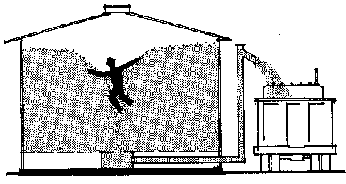
Figure 5. Flowing grain can trap and suffocate you in seconds.
- Don't enter a bin of flowing grain.
- Don't enter a bin to break a crust or remove a blockage when unloading equipment is running, whether or not grain is flowing. Restarted flow can trap you.
- Be alert while working with grain that has gone out of condition - there may be molds.
- Always wear a respirator capable of filtering fine dusts when working in obviously dusty-moldy grain.
- When entering a questionable bin or storage, have two outside and one inside workers. Attach a safety rope to the man in the bin with two men outside capable of lifting him out without entering the bin. One man outside cannot do this and cannot go for help while giving first aid.
- Before entering a bin or cleaning or repairing conveyors:
- Lock out the control circuit on automatic unloading equipment.
- Flag the switch on manual equipment, so someone else doesn't start it.
- Maintain proper and effective shields and guards on hazardous equipment.
Prepared by:
Kris Chawla - 1984
Source: Agdex 736-13. |
|